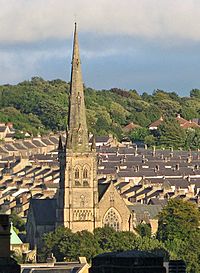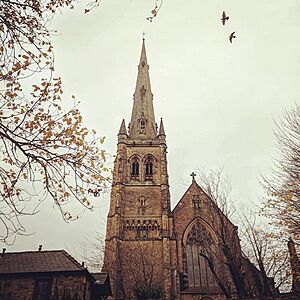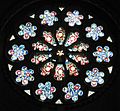Lancaster Cathedral facts for kids
Quick facts for kids Lancaster Cathedral |
|
|---|---|
| St Peter's Cathedral, Lancaster | |

Lancaster Cathedral showing the apsical east end, the steeple and the baptistry
|
|
| Lua error in Module:Location_map at line 420: attempt to index field 'wikibase' (a nil value). | |
| OS grid reference | SD 481,615 |
| Location | St Peter's Road, Lancaster, Lancashire |
| Country | England |
| Denomination | Roman Catholic |
| History | |
| Status | Cathedral |
| Dedication | Saint Peter |
| Architecture | |
| Heritage designation | Grade II* |
| Designated | 10 November 1994 |
| Architect(s) | E. G. Paley Austin and Paley |
| Style | Gothic Revival |
| Groundbreaking | 1857 |
| Completed | 1901 |
| Specifications | |
| Spire height | 240 feet (73 m) |
| Materials | Sandstone, with slate and copper roofs |
| Administration | |
| Diocese | Lancaster |
| Province | Liverpool |
Lancaster Cathedral, also known as The Cathedral Church of St Peter, is a Roman Catholic cathedral in Lancaster, England. A cathedral is a very important church that serves as the main church for a bishop in a diocese.
This building started as a regular parish church in 1857. It became a cathedral in 1924. The church was designed by E. G. Paley in a style called Gothic Revival. This means it looks like older Gothic churches from the Middle Ages. The cathedral is a "Grade II*" listed building, which means it's a very important historic building.
Over the years, parts of the cathedral have been added or changed. For example, a special room for baptisms (called a baptistry) was added in 1901. The cathedral is still used today for church services, concerts, and welcomes visitors.
Contents
History of Lancaster Cathedral
Before 1791, Roman Catholics in Lancaster had to meet in a simple, temporary chapel. But after a new law was passed, they could build proper churches. The very first Catholic church in Lancaster began construction in 1798. It was finished and blessed the next year.
By the mid-1800s, the Catholic community needed a much bigger church. So, they bought new land and started building the current church, dedicated to Saint Peter. The architect, E. G. Paley, had already designed other buildings on this land, like schools and a convent.
The foundation stone for the new church was laid on April 29, 1857. The church was officially blessed on October 4, 1859. Building the church and its related buildings cost a lot of money, about £15,000 at the time. Over the years, more features were added, including a font in 1860 and a new baptistry in 1901.
In 1909, the church celebrated its 50th birthday (golden jubilee). For this event, some changes were made, like adding a new altar and replacing the floor tiles with marble. In 1924, the church became a cathedral when the Diocese of Lancaster was created. This meant it became the main church for the bishop. The bishop's special chair, called a cathedra, was placed inside.
When the cathedral celebrated its 100th birthday in 1959, the pipe organ was repaired. Also, painted pictures showing the Stations of the Cross were replaced with carved ones. More changes have been made since then, keeping the cathedral beautiful and functional.
Architecture and Design
Outside the Cathedral
Lancaster Cathedral is built from sandstone, which is a type of rock. Its roofs are made of slate, except for the baptistry, which has a copper roof. The building is designed in the Gothic Revival style. This style often includes pointed arches, tall windows, and detailed stone carvings.
The cathedral has a long main part called a nave, with smaller sections on the sides called aisles. It also has parts that stick out, known as transepts, and a rounded end called an apse. A tall steeple stands at one corner, reaching about 240 feet (73 meters) high. The steeple has a tower with a spire on top.
The tower has different levels, with a small stair tower on one side. At the bottom of the tower, there's a porch with a statue of St Peter above it. The windows are often tall and narrow, with decorative stone patterns called tracery. For example, the west end of the church has a large window with five sections. The south transept has a beautiful round window, sometimes called a wheel window.
Inside the Cathedral
Inside, the cathedral has tall arches that separate the main nave from the aisles. There's also a gallery at the west end, supported by marble pillars. Along the sides, you'll find smaller chapels and confessionals.
The Lady Chapel, dedicated to the Virgin Mary, is in the northeast part of the cathedral. The Blessed Sacrament Chapel has special paintings on its walls. Behind the main altar, there's a large decorative screen called a reredos. This one was designed by Giles Gilbert Scott and has paintings and carvings.
The baptistry has a marble font in the middle. It also has an altar and beautiful stained glass windows made by Shrigley and Hunt. You can find more stained glass by this company and by Hardman & Co. throughout the cathedral.
The cathedral has an impressive pipe organ that was installed in 1889. It has three "manuals," which are like keyboards for the organist. The organ has been updated over the years and is still used for services and concerts. The cathedral also has a set of ten bells. Eight of these bells were made in 1879, and the other two were added in 1948.
Importance of the Cathedral
Lancaster Cathedral is considered a very important building. It was given a "Grade II*" listed building status in 1994. This means it's a particularly special building with significant historical and architectural value. Only about 5.5% of all listed buildings in England have this high grade.
Experts on architecture have called it one of the best works by its architect, E. G. Paley. They also describe the baptistry as a "tour de force," meaning it's a very impressive and skillful piece of design.
Visiting the Cathedral Today
Today, Lancaster Cathedral is still a busy and active Roman Catholic cathedral. It holds regular church services, known as Masses, and also hosts concerts and other events.
The cathedral is open every day for visitors who want to explore its beautiful architecture and learn about its history. It also welcomes groups and arranges educational visits, making it a great place to learn about faith, history, and art.
Gallery
-
The west window of the south aisle, produced by Shrigley and Hunt from designs by Carl Almquist
See also
 In Spanish: Catedral de San Pedro (Lancaster) para niños
In Spanish: Catedral de San Pedro (Lancaster) para niños








